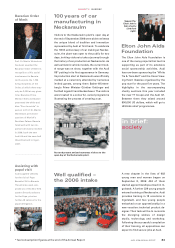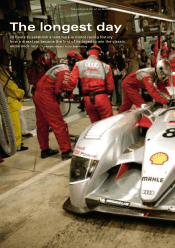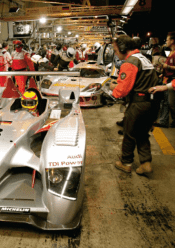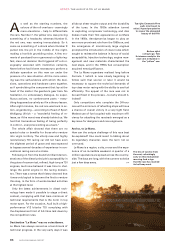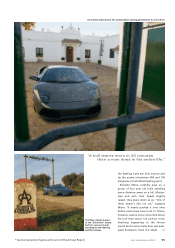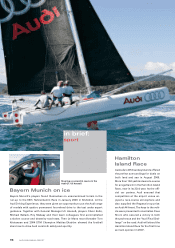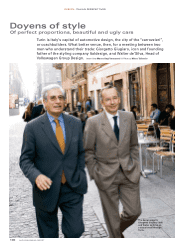Audi 2006 Annual Report Download - page 92
Download and view the complete annual report
Please find page 92 of the 2006 Audi annual report below. You can navigate through the pages in the report by either clicking on the pages listed below, or by using the keyword search tool below to find specific information within the annual report.
Herbert Völker, who for many years has been
editor-in-chief of the Austrian magazine
Autorevue, loves the Le Mans 24 Hours for
its incredibly successful blend of sport and
show: “The old lady of motor racing is now in finer
fettle than ever”.
Left: Marco Werner fully
wired up – acoustically,
visually and above all
emotionally, while his
colleague out on the
track clinches victory.
Top: still time for a sty-
listic study of functional
beauty, putting the
air stream in its place at
330 km/h.
Right: the result permit-
ting, the teams love to
cross the finishing line in
pairs at Le Mans. Biela,
Pirro and Werner (No. 8)
are the winners, Capello,
Kristensen and McNish
are third. Then it’s time
for the fans to take over.
SPORT: THE AUDI R10 TDI AT LE MANS
90 AUDI 2006 ANNUAL REPORT
“hot lap” for qualifying, Biela for the adrenalin
rush of the starting lap and Pirro for the honour
of the final “stint”, as it is known in racing par-
lance. According to the dictionary definition, a
stint is an “allocated task” or “shift”. At Le Mans,
a stint lasts as long as a tankful of fuel (90 litres)
allows. That normally means 12 laps, or about
three-quarters of an hour.
But the extra economy of the diesel principle
meant that the Audi cars managed to stay out on
the track for 14 laps at a time, saving four pit stops
over the whole distance. In the race’s closing
phase, when it was possible to step off the pace
a little, Tom Kristensen even managed to coax 16
laps out of a single tank of fuel. A sensational
achievement, and a new benchmark for the future.
The top speed at Le Mans is now roughly the
same for all top cars (335 km/h). It is intentional-
ly capped by the rules’ safety requirements and
the two chicanes on the long straight, where
someone clocked up a fearsome 406 km/h 15
years ago. Gone are the days when sheer top
speed was the be-all-and-end-all of this race.
It is now more a question of what speed is
driveable in every situation, and in the ordi-
nary business of racing it transpired that TDI-
powered cars clocked up laps an average of two
seconds faster than the fastest petrol engine. On
that basis, the race could already have been con-
sidered to be won, were it not for the incredible
imponderables of Le Mans which can come into
play right up until the final lap.
One striking aspect of the diesel racing car
caught the attention of the spectators in the
course of the long race: its low noise level. Put
differently, the R10 TDI is astonishingly quiet for
a 650 bhp racing car. The gears (there are only
five of them) are always changed at less than
5,000 rpm, with the result that from moderate
speeds upwards the drivers hear nothing at all of
the engine, because the wind noise is louder.
Frank Biela remarked: “That means you have to
concentrate even more than usual when braking
from a very high speed. You used to be able to
gauge when to shift down by the noise, but now
it was absent. You have to concentrate more on
the rev counter in the display. The positive thing
is that the low noise level is very agreeable over
long distances, so more relaxing for the driver.”
Fortune in the marathon.
A single moment of contact when overtaking a
straggler, a tyre puncture or even a tiny fault can
put you out of the race, however well you may be
doing. As fate would have it, the yellow car (Num-
ber 7) was stricken with a litany of misfortunes
necessitating four lengthy pit stops, followed by
an exhilarating chase that was finally rewarded
with third place in the final classification. Mean-
while the red car, apart from that horrible
moment in the middle of the night, clocked up
its laps unperturbed by all perils. Emanuele
Pirro, traditionally the man for that climactic mo-
ment, steered the all-conquering, unassailable
Audi R10 over the finishing line. By that point,
Biela, Pirro and Werner had put four laps be-
tween themselves and their nearest challenger.
An outpouring of emotions, a rapturous wel-
come and a place in the history books: the tri-
umph by the diesel-powered Audi R10 has
earned a prominent place in the annals of motor
sport. This was a triumph for the whole team and
the technicians in the background, and also a
ringing endorsement of one particular idea: how
to demonstrate trailblazing technology aptly at
major sporting events.





